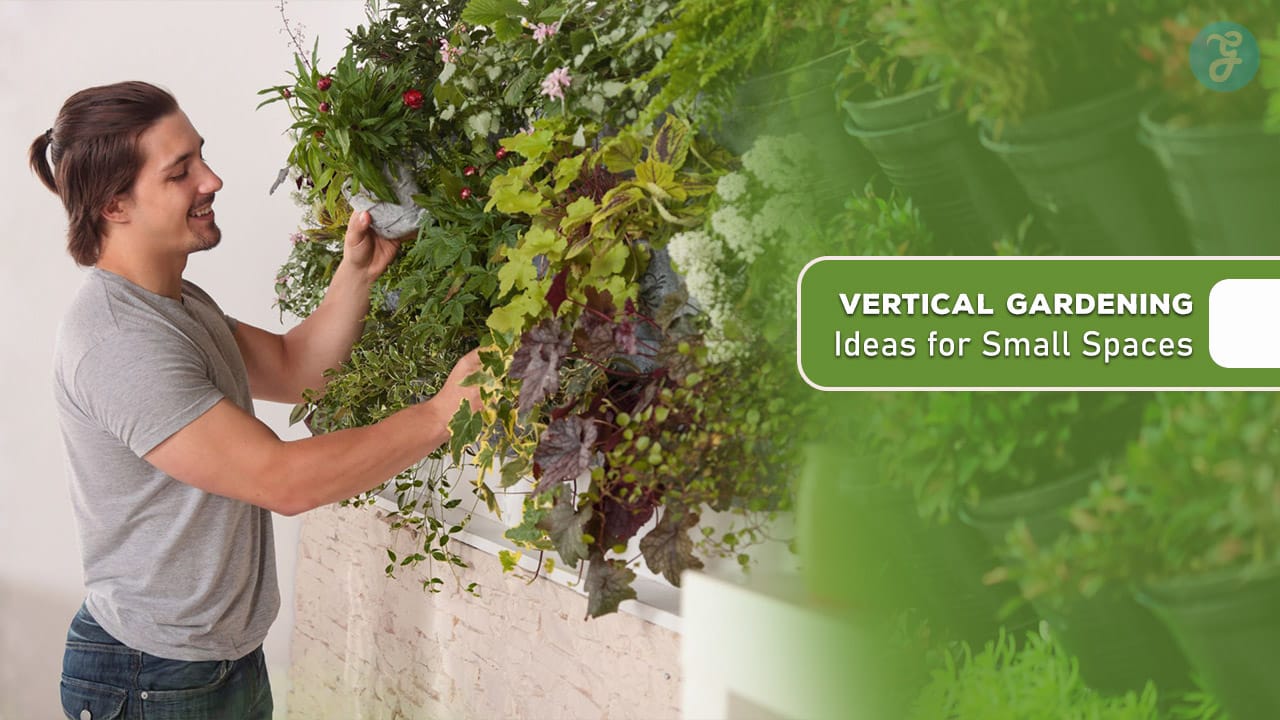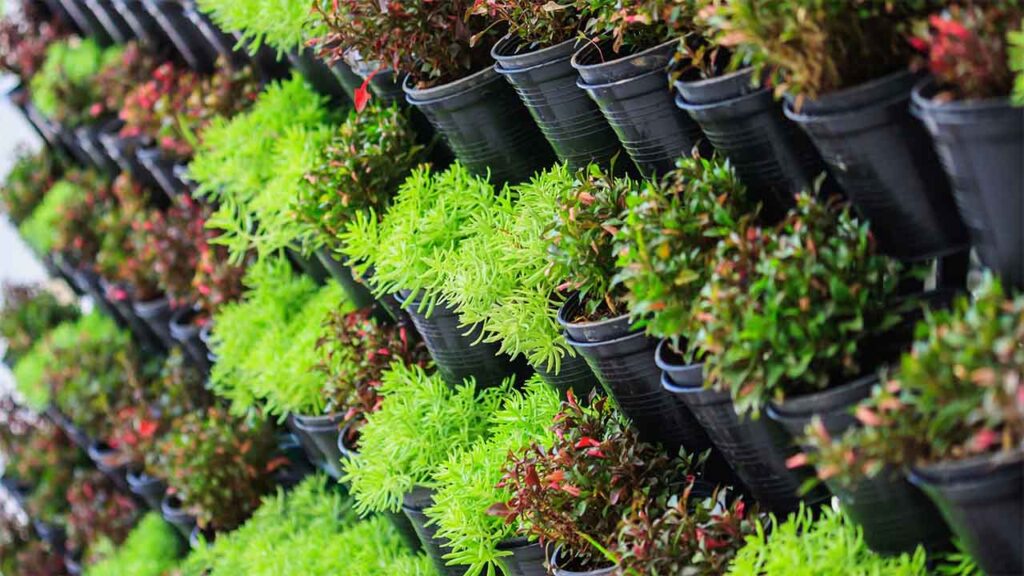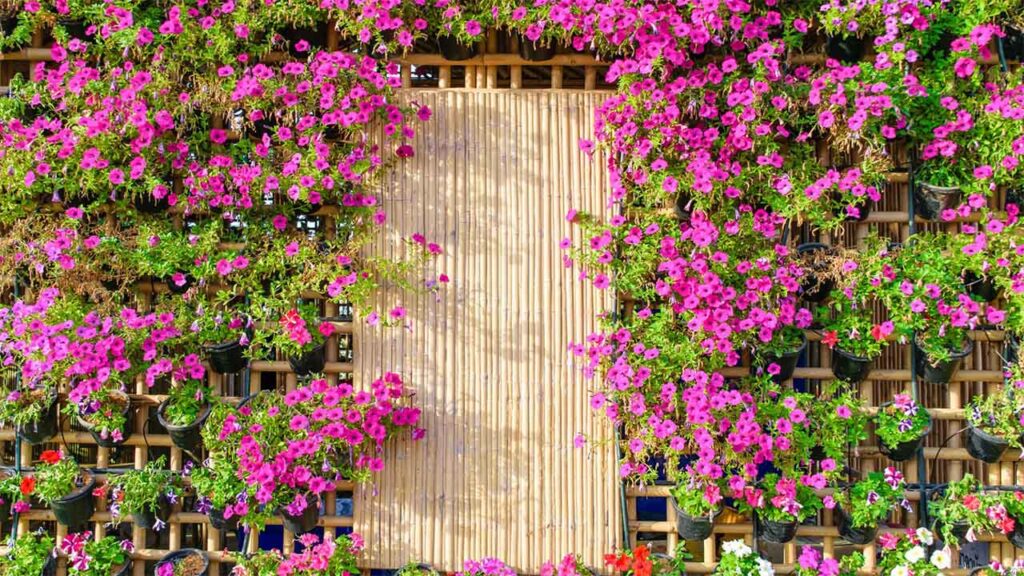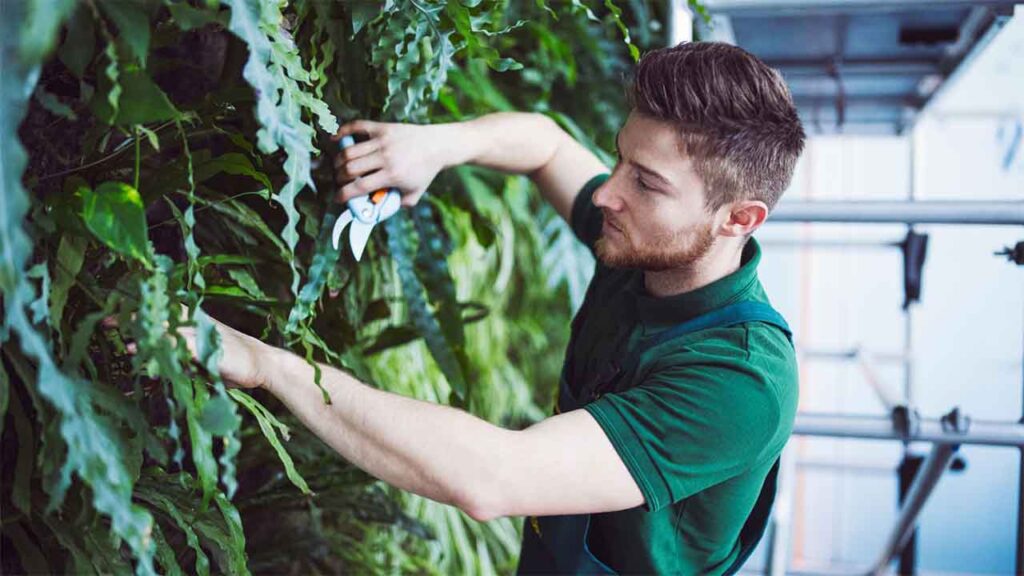Vertical gardening is a game-changer for people with limited outdoor space. You can grow plants up walls, on trellises, or in hanging containers. This opens up new possibilities for urban dwellers and those with small yards.
Vertical gardening ideas let you grow more in less space. You can plant herbs, flowers, and even some fruits and veggies.
These gardens add beauty to your home and help you make the most of every inch. With some creativity, you can turn bare walls and empty corners into lush green spaces.
1. Wall-Mounted Planters
Wall-mounted planters are a great way to grow plants vertically in small spaces. You can attach these planters directly to walls, fences, or other vertical surfaces. They come in many shapes, sizes, and materials to suit your style.
Plastic and metal planters are lightweight and easy to hang. Wooden planters add a natural look but need protection from moisture. Ceramic planters are decorative but heavier, so make sure your wall can support them.
You can grow herbs, small flowers, succulents, and even some vegetables in wall planters. Group several together to create a living wall of greenery. Make sure to choose plants that match the light conditions where you’ll hang the planters.
Water drainage is important for wall-mounted planters. Look for ones with built-in drainage holes or trays. You may need to water more often since the soil can dry out quickly in these smaller containers.
Wall planters let you maximize vertical space and add greenery to bare walls. They’re perfect for patios, balconies, and indoor spaces where floor space is limited. With the right plants and care, you can create a beautiful vertical garden using wall-mounted planters.
2. Hanging Herb Garden
Hanging herb gardens are perfect for small spaces. You can easily grow fresh herbs in your kitchen or on a balcony. These gardens save floor space and look great.
To start, choose lightweight containers. Plastic pots or fabric grow bags work well. Make sure they have drainage holes. You can hang them with rope, chains, or sturdy hooks.
Pick herbs that grow well in containers. Basil, mint, thyme, and oregano are good choices. These herbs don’t need deep soil and can thrive in hanging pots.
Place your hanging garden near a sunny window or outdoors. Most herbs need at least 6 hours of sunlight daily. Water your herbs regularly, but don’t let them get soggy.
You can create a DIY hanging herb garden with recycled materials. Use old tin cans, mason jars, or wooden crates. Paint them for a fun, colorful look.
For easy access, hang your herbs near your cooking area. This way, you can snip fresh herbs while you prepare meals. It’s both practical and decorative.
Remember to fertilize your herbs every few weeks. Use a balanced, water-soluble fertilizer. This will keep your plants healthy and productive.
3. Vertical Pallet Garden
Vertical pallet gardens are a great way to grow plants in small spaces. You can easily make one using an old wooden pallet. Clean the pallet and sand it to remove any splinters.
Stand the pallet upright against a wall or fence. Staple landscape fabric to the back and sides to hold soil. Fill the spaces between slats with potting soil.
Choose plants that suit your climate and light conditions. Herbs, succulents, and small flowers work well. Plant them in the soil-filled spaces between the pallet slats.
Water your pallet garden regularly. The top plants may need more water than the bottom ones. Add a drip irrigation system for easier watering.
Paint or stain your pallet to match your decor. You can also add hooks or shelves for extra storage. A vertical pallet garden saves space and adds greenery to any area.
4. Gutter Garden
Gutter gardens are a clever way to grow plants in small spaces. You can mount rain gutters on walls or fences to create vertical planters. This method works well for herbs, small vegetables, and flowers.
To make a gutter garden, start by cleaning used gutters or buying new ones. Cut them to your desired length and seal the ends. Drill drainage holes in the bottom to prevent water buildup.
Secure the gutters to your chosen surface with brackets. Make sure they’re level so water doesn’t pool at one end. Fill the gutters with potting soil and plant your chosen seeds or seedlings.
Gutter gardens are great for growing lettuce, spinach, and other leafy greens. You can also plant trailing flowers to create a cascading effect. Remember to water your gutter garden regularly, as the soil can dry out quickly.
This vertical gardening idea is perfect for balconies, patios, or even indoor spaces with good lighting. It’s an easy DIY project that can transform a bare wall into a thriving garden.
5. Pocket Planters
Pocket planters are a clever way to grow plants vertically in small spaces. These handy containers attach to walls or fences, creating a living tapestry of greenery.
You can buy ready-made pocket planters or make your own. DIY options include repurposing shoe organizers or creating custom pockets from sturdy fabric. Hang them on indoor or outdoor walls to maximize growing space.
These planters work well for herbs, small flowers, and succulents. The pockets keep soil contained while allowing excess water to drain. This prevents overwatering and root rot.
When choosing plants, consider how much sun your wall receives. Group plants with similar light and water needs together. This makes care easier and ensures all your plants thrive.
Water pocket planters carefully to avoid drips. A small watering can with a narrow spout works best. You may need to water more often than traditional pots, as vertical gardens can dry out quickly.
Pocket planters add visual interest to blank walls. Try arranging plants in patterns or grouping similar colors together. You can easily swap out plants to change the look with the seasons.
6. Tiered Ladder Shelves
Tiered ladder shelves offer a smart solution for small-space gardening. You can easily create this vertical garden using an old wooden ladder or build one from scratch.
To set up your ladder planter, place wooden boards across each rung. This creates multiple levels for your plants. You can adjust the spacing between shelves to fit different pot sizes.
Choose plants that suit your space and light conditions. Put sun-loving plants on the top shelves and shade-tolerant ones lower down. Mix herbs, flowers, and small vegetables for variety.
Secure your ladder against a wall or fence for stability. Add casters to the bottom if you want to move it around. This lets you change its position as seasons and sunlight patterns shift.
Paint or stain your ladder to match your decor. Use bright colors for a fun look or natural wood tones for a rustic feel. You can even add hooks to hang gardening tools or extra pots.
Tiered ladder shelves work well indoors too. Place one in a sunny spot near a window for year-round growing. It’s perfect for nurturing houseplants or starting seedlings.
Remember to put trays under your pots to catch water. This protects your ladder and keeps things tidy. With proper care, your ladder garden will thrive and add beauty to your space.
7. Freestanding Trellises
Freestanding trellises are perfect for small spaces. They let you grow plants upward without needing a wall or fence.
You can place these trellises anywhere in your garden or patio. They come in many shapes and sizes. Some are flat panels, while others are pyramid-shaped or curved.
Choose a sturdy trellis that can support your plants. Metal or wood are good options. Make sure it’s tall enough for the plants you want to grow.
Climbing plants love trellises. You can grow beans, peas, or flowering vines like clematis. These plants will cover the trellis and create a green wall.
Freestanding trellises also work well for container gardens. Put a pot at the base of the trellis and let your plants climb up.
You can use trellises to create privacy or divide spaces in your garden. Place several in a row to make a screen.
Remember to secure your trellis if it’s in a windy area. You don’t want it to fall over when your plants get big.
8. Living Wall Art
Living wall art brings nature indoors in a stunning way. You can create a beautiful green focal point in your home or office with this vertical gardening technique.
To start, choose a frame or panel system designed for living walls. These often have built-in irrigation and drainage. Pick plants that thrive in vertical settings like ferns, bromeliads, and small succulents.
Arrange your plants in an artistic pattern. Mix different textures, colors, and sizes for visual interest. You can spell out words or create abstract designs with careful plant placement.
Water and care are key for living wall success. Most systems need regular watering and occasional pruning. Make sure your wall gets enough light – natural or artificial – to keep plants healthy.
Living walls clean your air and boost your mood. They add a touch of nature to urban spaces. With some creativity, you can turn any blank wall into a lush, living masterpiece.
9. Leaning Ladder Garden
Want to add a unique twist to your vertical garden? Try a leaning ladder garden. This charming idea uses an old wooden ladder as a plant display.
Lean the ladder against a wall or fence. Place potted plants on each rung. You can use small pots for herbs or flowers. Larger pots work well for trailing plants.
Paint the ladder to match your style. A rustic look works great for outdoor spaces. For indoor use, try a bright color to make it pop.
Safety is key. Make sure the ladder is sturdy and won’t tip over. Secure it to the wall if needed. This prevents accidents and protects your plants.
Ladders are perfect for small spaces. They take up little floor space but offer lots of planting area. You can easily move them around too.
Mix different plants for visual interest. Put sun-loving plants on top rungs and shade-lovers on bottom ones. This creates a lush, green look.
Water carefully to avoid drips. Use saucers under pots or hang them with hooks. This keeps your floor clean and dry.
A leaning ladder garden adds charm to any space. It’s a simple way to grow more plants in tight spots.
10. Vertical Hydroponic System
Vertical hydroponic systems are perfect for small spaces. They let you grow plants without soil using nutrient-rich water.
These systems use pipes or towers stacked vertically. You can fit many plants in a small area this way.
Plants grow faster in hydroponic systems. They get nutrients directly through their roots. This means bigger harvests in less time.
You can grow herbs, leafy greens, and even small fruits in these systems. Lettuce, spinach, and strawberries do well.
Building your own system is possible. You’ll need PVC pipes, a pump, and growing medium like perlite. Net pots hold the plants in place.
Pre-made kits are also available if you don’t want to DIY. These come with everything you need to get started.
Vertical hydroponic gardens use less water than traditional gardens. The water recirculates, so nothing is wasted.
You can grow indoors or outdoors with these systems. Just make sure plants get enough light wherever you put them.
Maintenance is easy. You’ll need to check water levels and pH regularly. Nutrients should be added as needed.
With vertical hydroponics, you can have a thriving garden in any small space. It’s a great way to grow fresh food at home.
11. Repurposed Shoe Organizer Planter
Got an old shoe organizer collecting dust? Turn it into a vertical garden! This clever idea lets you grow plants in small spaces.
Hang the organizer on a wall or fence that gets good sunlight. Fill each pocket with potting soil. Then plant herbs, flowers, or small vegetables in the pockets.
You can grow different plants in each row. Try putting sun-loving plants up top and shade plants lower down. Water your plants regularly and watch them thrive!
This DIY project is easy and cheap. It’s great for patios, balconies, or even indoors near a sunny window. You’ll have fresh herbs for cooking or pretty flowers to enjoy.
Remember to line the pockets with plastic if the fabric isn’t waterproof. This stops water from leaking out. Small drainage holes will help your plants stay healthy.
Shoe organizer planters work well for shallow-rooted plants. Good choices include lettuce, strawberries, succulents, and many herbs. You can even mix and match to create a colorful display.
12. PVC Pipe Garden
PVC pipe gardens are a smart choice for small spaces. They let you grow plants vertically, saving room on your patio or balcony.
To make one, you’ll need PVC pipes, soil, and plants. Cut holes in the pipes for your plants to grow through. Hang the pipes on a wall or fence using brackets.
This type of garden works well for herbs and small vegetables. Think basil, lettuce, or cherry tomatoes. You can easily water your plants from the top of the pipe.
PVC pipe gardens are cheap to make and easy to maintain. They’re also lightweight, so you can move them if needed. Plus, they keep your plants off the ground, away from pests.
You can paint the pipes to match your decor. This makes them look nice while still being useful. With a PVC pipe garden, you’ll have fresh herbs and veggies right at your fingertips.
13. Stackable Planters
Stackable planters are a game-changer for small-space gardening. You can create a vertical garden that’s both space-saving and mobile.
These planters come in different sizes and styles. Some are designed specifically for herbs or strawberries, while others work well for various plants.
You’ll find stackable planters in materials like plastic, terracotta, and stone. Colors range from classic earth tones to bold hues that add visual interest to your space.
One popular option is the 5-tier planter system. It typically offers 20 separate growing spots in a compact design. This setup is perfect for herbs, small vegetables, and flowers.
Stackable planters are easy to assemble and maintain. You can move them around to catch the best sunlight or bring them indoors during harsh weather.
Some systems include built-in water reservoirs. This feature helps distribute moisture evenly and reduces how often you need to water your plants.
When choosing stackable planters, consider the types of plants you want to grow. Make sure the containers are deep enough for their root systems.
You can mix and match different plants in your stackable garden. Try combining colorful flowers with useful herbs for a practical and attractive display.
14. Geometric Wall Planters
Geometric wall planters add a modern touch to your vertical garden. These eye-catching containers come in various shapes like triangles, hexagons, and diamonds. You can arrange them in patterns on your wall for a unique look.
Choose planters made of materials like concrete, metal, or wood. Concrete offers durability, while metal gives a sleek appearance. Wood adds warmth to your space. Mix and match materials for visual interest.
Pick plants that suit the planter size and your space’s light conditions. Succulents work well in smaller geometric planters. Herbs or small flowering plants can thrive in larger ones. Group planters with similar care needs together.
Attach the planters securely to your wall. Use strong brackets or mounting hardware. Make sure the wall can support the weight of the planters when filled with soil and plants.
Water your plants carefully to avoid damaging your wall. Use a small watering can or spray bottle. Place a drip tray under each planter to catch excess water.
Geometric wall planters let you create living art. They’re perfect for adding greenery to small spaces like balconies or indoor walls. You can easily change the arrangement to refresh your garden’s look.
15. Chicken Wire Wall Garden
Want to make the most of your small space? Try a chicken wire wall garden. This easy DIY project lets you grow plants vertically.
Start by attaching chicken wire to a wooden frame. Hang it on a wall or fence. The wire creates pockets for plants to grow in.
Fill small pots with soil and your favorite plants. Herbs, succulents, and small flowers work well. Attach the pots to the wire using hooks or zip ties.
Water your plants regularly. Make sure they get enough sunlight. You can move pots around to change up the look of your garden.
This type of garden is great for patios, balconies, or small yards. It adds greenery without taking up floor space. You can grow fresh herbs for cooking right outside your kitchen.
Chicken wire wall gardens are budget-friendly and customizable. Paint the frame to match your decor. Add more wire sections to expand your garden as needed.
Benefits of Vertical Gardening
Vertical gardening offers many advantages for small spaces. You can grow more plants, make your area look better, and even improve the air around you.
Space-Saving Solutions
Vertical gardens let you grow up instead of out. You can fit more plants in less floor space. This works great for small yards, balconies, or indoor areas.
Use wall-mounted planters or shelves to grow herbs and small veggies. Hang pots from the ceiling or railings for trailing plants. Stack containers on top of each other to create a tower garden.
Trellises and supports help vining plants grow upwards. This frees up ground space for other uses. You can grow cucumbers, beans, or peas vertically along fences or walls.
Enhanced Aesthetics
Vertical gardens add beauty to plain walls and fences. They create living art that changes with the seasons. You can design patterns and color schemes with different plants.
Use flowering vines to cover ugly surfaces. Plant colorful annuals in pocket planters for a burst of color. Mix textures by combining ferns, succulents, and leafy plants.
Vertical gardens can serve as natural privacy screens. They block views and muffle noise. This helps create a cozy outdoor space in urban areas.
Improved Air Quality
Plants in vertical gardens clean the air around you. They absorb carbon dioxide and release oxygen. This is especially helpful indoors or in polluted city areas.
Some plants are better at removing toxins from the air. Try growing spider plants, peace lilies, or snake plants vertically. These can help filter out common indoor pollutants.
Vertical gardens add moisture to dry indoor air. This can help reduce respiratory issues and dry skin. The plants also trap dust and other particles, improving overall air quality.
Ideal Plants for Vertical Gardens
Vertical gardens allow you to grow a variety of plants in small spaces. The best options are lightweight, compact, and don’t need deep soil. Let’s explore some great choices for your vertical garden.
Herbs and Vegetables
Herbs are perfect for vertical gardens. They’re small, fast-growing, and useful in cooking. Try basil, mint, oregano, or thyme. These plants don’t need much space and grow well in small pots or pockets.
Leafy greens also work great. You can grow lettuce, spinach, and kale vertically. These plants have shallow roots and don’t get too heavy. Cherry tomatoes and small peppers can also thrive in vertical setups if given enough support.
For a unique touch, try growing strawberries in a vertical garden. They trail nicely and produce sweet fruits right at eye level.
Flowering Plants
Petunias, pansies, and impatiens add bright colors to vertical gardens. These flowers are small and bloom for long periods. They don’t need deep soil, making them ideal for wall-mounted planters.
Trailing plants like lobelia or bacopa create a waterfall effect. They spill over the edges of containers, softening the look of your vertical garden.
For year-round interest, try ferns or ivy. These plants stay green and lush even in cooler months. They’re also low-maintenance and can tolerate less light than many flowering plants.
Succulents and Cacti
Succulents are stars of vertical gardening. They’re lightweight, need little water, and come in many shapes and colors. Try echeverias, sedums, or jade plants for a mix of textures.
Cacti also work well in vertical gardens. They’re tough and can handle hot, dry conditions. Choose smaller varieties like button cacti or Christmas cacti to fit in tight spaces.
Mix different types of succulents and cacti for an eye-catching display. Their varied forms and colors create natural art on your wall.
Vertical Garden Maintenance
Keeping your vertical garden thriving takes some regular care. With the right approach, you can enjoy lush, healthy plants year-round.
Watering and Irrigation
Vertical gardens need frequent watering. The soil dries out faster than in regular gardens. Check moisture levels daily. Water when the top inch of soil feels dry.
Drip irrigation systems work well for vertical gardens. They deliver water right to plant roots. This saves time and ensures even watering. You can set timers to water automatically.
For small gardens, use a watering can or spray bottle. Water slowly so it soaks in. Avoid getting water on leaves to prevent disease.
Fertilization Tips
Feed your vertical garden every 2-4 weeks during the growing season. Use a balanced, water-soluble fertilizer. Mix it at half strength to avoid burning plants.
Slow-release fertilizers are another good option. They feed plants gradually over time. Apply them once a season according to package directions.
For edible plants, use organic fertilizers. Fish emulsion or compost tea work well. They give plants nutrients without harsh chemicals.
Pest Control
Check plants often for pests. Look under leaves and in plant crevices. Common pests include aphids, spider mites, and whiteflies.
Remove bugs by hand when possible. Spray plants with a strong stream of water to knock off pests. For bigger problems, use insecticidal soap or neem oil.
Keep plants healthy to prevent pest issues. Remove dead leaves and stems promptly. Make sure plants have good air flow. This cuts down on fungal problems and pest habitats.
Final Thoughts
Vertical gardening offers an exciting solution for urban dwellers and those with limited outdoor space.
By thinking upwards, you can transform even the smallest balcony, patio, or indoor area into a lush, productive oasis. From wall-mounted planters and hanging herb gardens to innovative DIY projects like pallet gardens and PVC pipe systems, there’s a vertical gardening option to suit every style and budget.
These space-saving techniques not only maximize your growing potential but also add beauty to your surroundings, improve air quality, and provide fresh herbs and vegetables right at your fingertips.
With proper planning, care, and maintenance, your vertical garden can thrive year-round, bringing the joys of gardening to even the most compact living spaces.







































